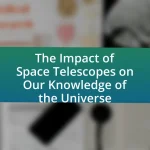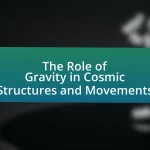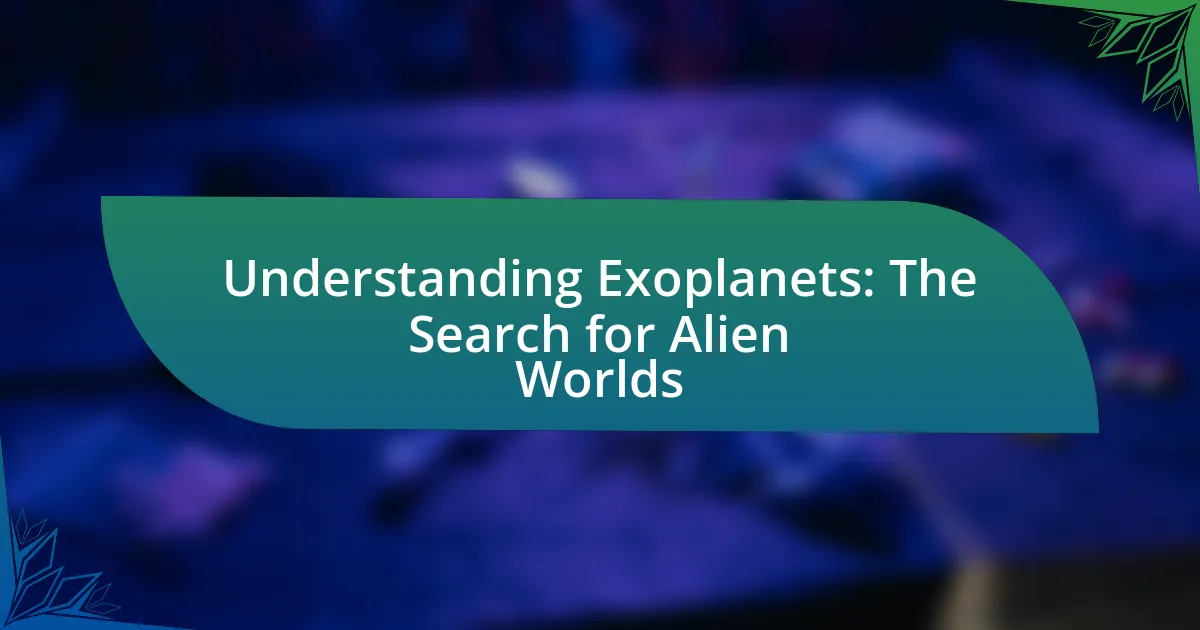Citizen science significantly contributes to cosmic exploration by allowing non-professionals to engage in astronomical research and data collection. Projects like Galaxy Zoo exemplify this collaboration, where volunteers classify millions of galaxies, enhancing data analysis and accelerating research. Citizen scientists also monitor celestial events, providing valuable observations that complement professional astronomers’ work. This involvement democratizes science, fosters public interest in astronomy, and leads to discoveries such as new galaxy types and transient astronomical events. The article explores the various roles, challenges, and future prospects of citizen science in advancing our understanding of the cosmos.
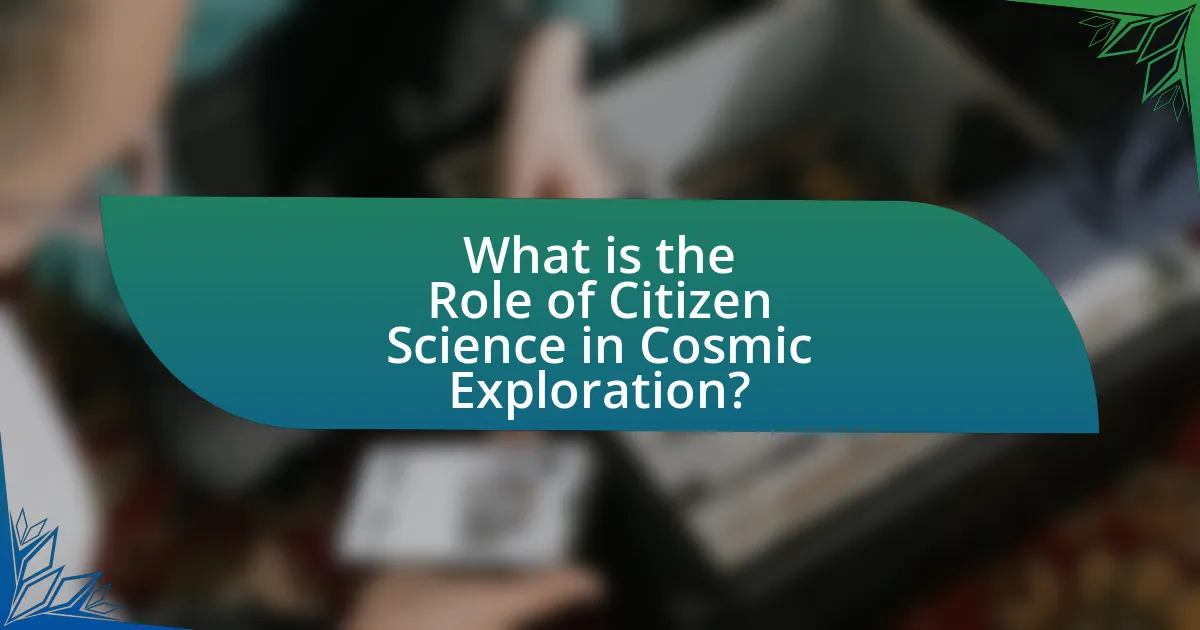
What is the Role of Citizen Science in Cosmic Exploration?
Citizen science plays a crucial role in cosmic exploration by enabling non-professionals to contribute to astronomical research and data collection. This collaborative approach enhances the volume of data analyzed, as seen in projects like Galaxy Zoo, where volunteers classify millions of galaxies, significantly accelerating the pace of research. Additionally, citizen scientists help in monitoring celestial events, such as meteor showers and exoplanet transits, providing valuable observations that complement professional astronomers’ work. The involvement of the public not only democratizes science but also fosters greater interest and understanding of cosmic phenomena, as evidenced by the increased engagement in astronomy-related activities and education initiatives.
How does citizen science contribute to our understanding of the cosmos?
Citizen science significantly enhances our understanding of the cosmos by enabling non-professionals to participate in astronomical research, leading to the collection of vast amounts of data. For instance, projects like Galaxy Zoo allow volunteers to classify millions of galaxies, contributing to the study of galaxy formation and evolution. This collaborative effort has resulted in the discovery of new astronomical phenomena, such as the identification of rare galaxy types and the mapping of cosmic structures. Additionally, citizen scientists have played a crucial role in monitoring transient astronomical events, such as supernovae and asteroids, which helps refine our knowledge of cosmic dynamics and potential threats to Earth.
What types of projects involve citizen scientists in cosmic exploration?
Citizen scientists participate in various projects related to cosmic exploration, including astronomical observations, data analysis, and planetary exploration initiatives. Projects like Galaxy Zoo engage volunteers in classifying galaxies based on images from telescopes, while the Planet Hunters project allows participants to identify exoplanets by analyzing light curves from stars. Additionally, initiatives such as the Solar System Ambassadors program enable citizen scientists to share knowledge about space missions and discoveries. These projects leverage the collective efforts of non-professionals to enhance scientific research and data collection in the field of astronomy.
How do citizen scientists collect and analyze data in cosmic research?
Citizen scientists collect and analyze data in cosmic research primarily through collaborative platforms and specialized software tools. They engage in activities such as classifying astronomical images, monitoring variable stars, and participating in large-scale surveys like the Galaxy Zoo project, which has involved over 100,000 volunteers who classified millions of galaxies. These platforms often provide user-friendly interfaces that allow non-experts to contribute effectively, while the data collected is then analyzed using statistical methods and algorithms to identify patterns or anomalies. The contributions of citizen scientists have led to significant discoveries, such as the identification of new exoplanets and the observation of transient astronomical events, demonstrating their valuable role in advancing cosmic research.
Why is citizen science important for cosmic exploration?
Citizen science is important for cosmic exploration because it enhances data collection and analysis through the involvement of the public. By engaging non-professionals in scientific research, citizen science projects can gather vast amounts of observational data that would be difficult for professional scientists to collect alone. For instance, projects like Galaxy Zoo have utilized thousands of volunteers to classify millions of galaxies, significantly accelerating the pace of astronomical research. This collaborative approach not only democratizes science but also fosters public interest and education in astronomy, leading to a more informed society about cosmic phenomena.
What unique perspectives do citizen scientists bring to astronomical research?
Citizen scientists bring diverse perspectives to astronomical research by contributing unique observations, local knowledge, and innovative problem-solving skills. Their involvement allows for the collection of large datasets that professional astronomers may not have the resources to gather, such as monitoring transient astronomical events or classifying celestial objects. For instance, the Galaxy Zoo project, which engaged thousands of volunteers to classify galaxies, resulted in significant discoveries, including the identification of new galaxy types. This collaborative approach enhances the breadth of research and fosters a more inclusive scientific community, ultimately enriching the field of astronomy.
How does citizen science enhance public engagement with space science?
Citizen science enhances public engagement with space science by actively involving individuals in scientific research, allowing them to contribute to real-world projects. This participation fosters a sense of ownership and connection to space science, as citizens analyze data, identify celestial objects, and even participate in missions, such as the Galaxy Zoo project, where volunteers classify galaxies from telescope images. Studies show that such involvement increases public interest and understanding of space, with over 100,000 participants contributing to the Galaxy Zoo alone, demonstrating the effectiveness of citizen science in making complex scientific concepts accessible and engaging to a broader audience.
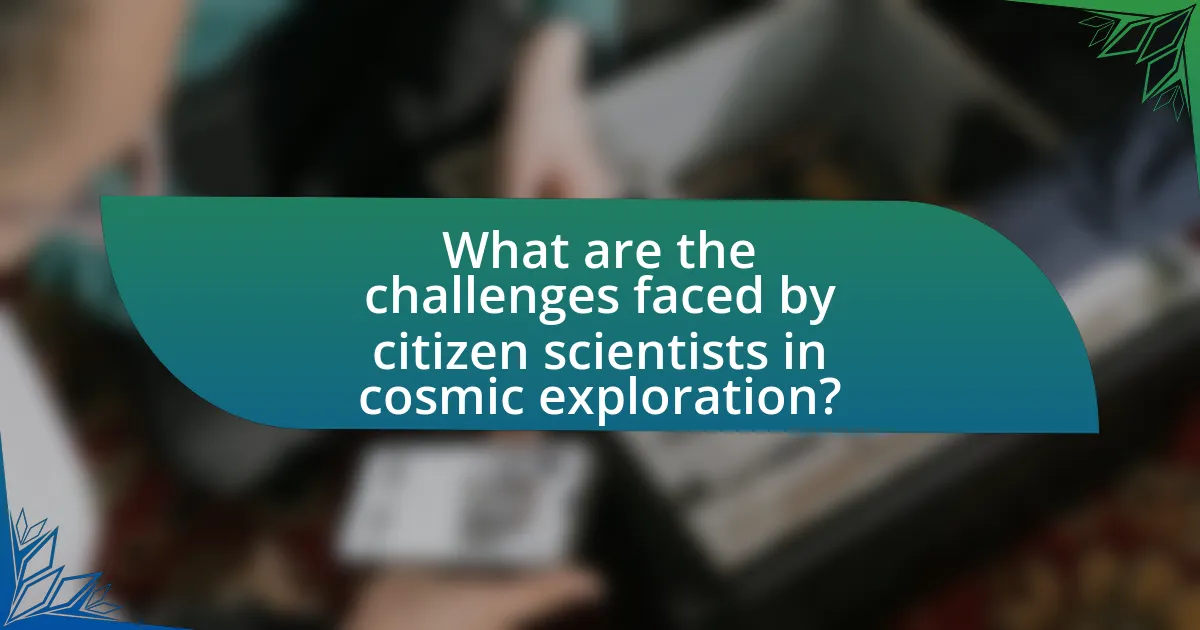
What are the challenges faced by citizen scientists in cosmic exploration?
Citizen scientists in cosmic exploration face several challenges, including limited access to advanced technology, lack of formal training, and difficulties in data validation. Limited access to sophisticated telescopes and equipment restricts their ability to gather high-quality data, which is essential for meaningful contributions to cosmic research. Additionally, many citizen scientists lack formal training in astrophysics or data analysis, making it challenging to interpret complex astronomical data accurately. Furthermore, the validation of data collected by citizen scientists is often problematic, as professional astronomers must verify the findings to ensure reliability, which can lead to delays in research progress. These challenges hinder the overall effectiveness and impact of citizen science in the field of cosmic exploration.
What obstacles do citizen scientists encounter when participating in cosmic projects?
Citizen scientists encounter several obstacles when participating in cosmic projects, including limited access to data, lack of technical expertise, and challenges in collaboration. Limited access to data arises because many cosmic projects require proprietary or complex datasets that are not readily available to the public. Lack of technical expertise can hinder citizen scientists from effectively contributing, as many projects involve advanced scientific concepts and tools that require specialized knowledge. Additionally, challenges in collaboration occur when citizen scientists struggle to communicate and coordinate with professional scientists, which can lead to misunderstandings and inefficiencies in project execution. These obstacles can significantly impact the effectiveness and engagement of citizen scientists in cosmic exploration initiatives.
How can technology improve the experience of citizen scientists in cosmic exploration?
Technology can enhance the experience of citizen scientists in cosmic exploration by providing advanced tools for data collection, analysis, and collaboration. For instance, mobile applications and online platforms enable citizen scientists to easily contribute observations and findings, such as identifying celestial objects or reporting astronomical events. These platforms often incorporate machine learning algorithms that assist in analyzing large datasets, making it easier for non-experts to engage with complex information. Additionally, virtual reality and augmented reality technologies can offer immersive experiences, allowing citizen scientists to visualize cosmic phenomena in a more interactive manner. Research shows that platforms like Galaxy Zoo have successfully engaged thousands of volunteers in classifying galaxies, demonstrating the effectiveness of technology in facilitating citizen participation in scientific research.
What training or resources are available to support citizen scientists?
Training and resources available to support citizen scientists include online courses, workshops, and dedicated platforms for data collection and analysis. For instance, organizations like Zooniverse offer a variety of projects that provide tutorials and guides to help citizen scientists engage effectively. Additionally, NASA’s Citizen Science program provides resources such as webinars and instructional materials to facilitate participation in cosmic exploration projects. These resources are designed to enhance skills in scientific methods and data interpretation, ensuring that citizen scientists can contribute meaningfully to research initiatives.
How do collaborations between professionals and citizen scientists work?
Collaborations between professionals and citizen scientists work through structured partnerships where both parties contribute their expertise to advance scientific research. Professionals, such as astronomers or researchers, provide guidance, training, and access to resources, while citizen scientists collect data, analyze findings, and engage in outreach activities. This synergy enhances research capabilities, as seen in projects like Galaxy Zoo, where volunteers classify galaxies, significantly accelerating data processing and expanding the scope of astronomical studies. Such collaborations leverage the diverse skills of citizen scientists, leading to innovative discoveries and increased public engagement in science.
What roles do professional astronomers play in citizen science initiatives?
Professional astronomers play critical roles in citizen science initiatives by providing expertise, guidance, and validation of data collected by non-professionals. They design projects that leverage the unique capabilities of citizen scientists, such as monitoring celestial events or classifying astronomical objects. For instance, projects like Galaxy Zoo have shown that professional astronomers can effectively utilize the large-scale data processing power of citizen contributions, leading to significant discoveries in galaxy morphology. Additionally, professional astronomers often analyze the data generated by citizen scientists to ensure scientific rigor and accuracy, thereby enhancing the overall quality of research outcomes.
How can effective communication enhance collaboration in cosmic exploration?
Effective communication enhances collaboration in cosmic exploration by facilitating the exchange of ideas, data, and expertise among diverse teams. Clear communication ensures that scientists, engineers, and citizen scientists can share findings and insights, leading to more innovative solutions and discoveries. For instance, NASA’s citizen science projects, such as Galaxy Zoo, demonstrate how effective communication allows volunteers to contribute to data analysis, significantly increasing the volume of research conducted. This collaborative approach has resulted in the identification of new galaxies and improved understanding of cosmic phenomena, showcasing the tangible benefits of effective communication in advancing cosmic exploration.
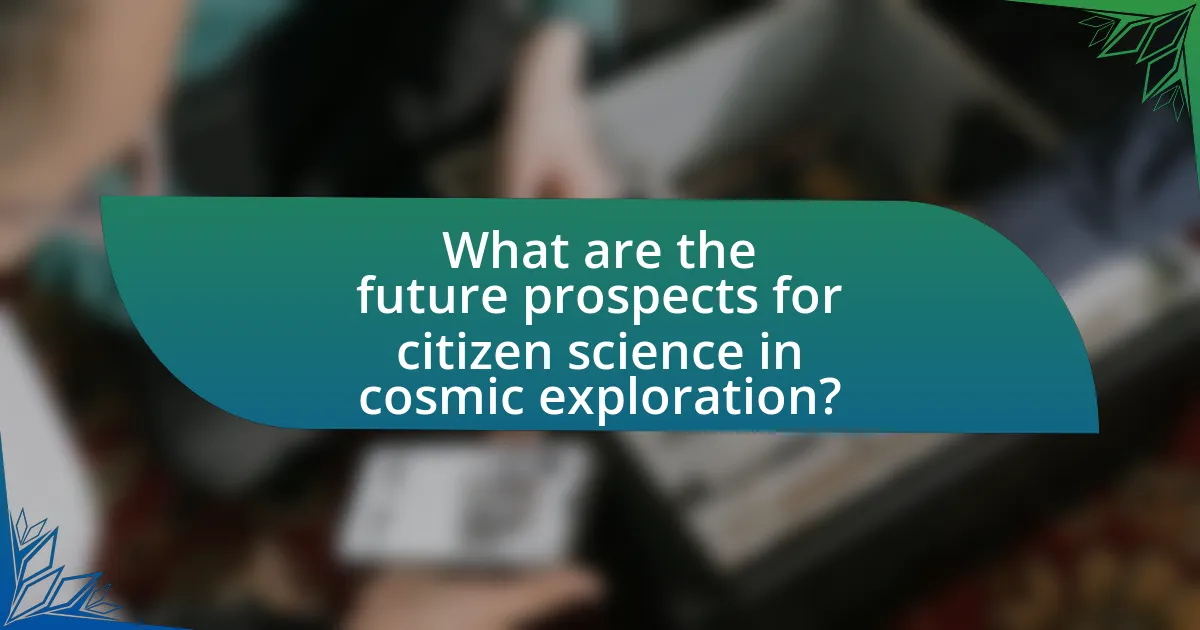
What are the future prospects for citizen science in cosmic exploration?
The future prospects for citizen science in cosmic exploration are promising, as advancements in technology and data accessibility enable broader public participation. Citizen scientists can contribute to astronomical research by analyzing vast datasets from telescopes and space missions, such as the data from the James Webb Space Telescope, which is expected to generate significant public interest and involvement. Additionally, platforms like Galaxy Zoo have demonstrated that non-experts can effectively classify galaxies, leading to new discoveries. The increasing integration of citizen science into formal research processes is supported by initiatives from organizations like NASA and the European Space Agency, which actively encourage public engagement in scientific endeavors.
How is technology shaping the future of citizen science in astronomy?
Technology is significantly shaping the future of citizen science in astronomy by enhancing data collection, analysis, and collaboration capabilities. Advanced tools such as mobile applications, online platforms, and artificial intelligence enable amateur astronomers to contribute effectively to scientific research. For instance, projects like Galaxy Zoo utilize machine learning algorithms to classify galaxies based on images provided by citizen scientists, demonstrating how technology streamlines complex tasks and increases participation. Additionally, the proliferation of accessible telescopes and imaging software allows individuals to gather and share astronomical data, fostering a global community of contributors. This technological integration not only democratizes scientific inquiry but also accelerates discoveries in the field of astronomy.
What emerging trends are influencing citizen science projects in cosmic exploration?
Emerging trends influencing citizen science projects in cosmic exploration include the integration of advanced technology, increased collaboration with professional scientists, and the rise of online platforms for data sharing. Advanced technology, such as artificial intelligence and machine learning, enhances data analysis capabilities, allowing citizen scientists to process vast amounts of astronomical data more efficiently. Increased collaboration with professional scientists fosters a more structured approach to projects, ensuring that citizen contributions are scientifically valid and impactful. Additionally, online platforms facilitate global participation, enabling diverse contributions and real-time data sharing, which enhances the overall scope and reach of cosmic exploration initiatives. These trends collectively enhance the effectiveness and inclusivity of citizen science in the field of astronomy.
How can citizen science evolve to address new challenges in space research?
Citizen science can evolve to address new challenges in space research by leveraging advanced technology and collaborative platforms to enhance data collection and analysis. For instance, the integration of artificial intelligence and machine learning can enable citizen scientists to process vast amounts of astronomical data more efficiently, identifying patterns and anomalies that may be overlooked by traditional methods. Additionally, initiatives like the Zooniverse platform have demonstrated that engaging the public in tasks such as classifying celestial objects can significantly increase the volume of data analyzed, leading to new discoveries. Research shows that citizen science projects have contributed to significant findings, such as the discovery of new exoplanets through the Kepler Space Telescope data, highlighting the potential for public involvement in addressing complex scientific questions.
What practical tips can citizen scientists follow to maximize their impact?
Citizen scientists can maximize their impact by focusing on data quality, collaboration, and education. Ensuring high-quality data collection involves following established protocols and using reliable tools, which enhances the credibility of their contributions. Collaboration with professional scientists can lead to more significant findings, as citizen scientists can provide large datasets that complement expert research. Engaging in educational outreach helps raise awareness about cosmic exploration and encourages more individuals to participate, thereby expanding the citizen science community. These strategies are supported by studies showing that well-organized citizen science projects can yield results comparable to those of professional researchers, as evidenced by the success of initiatives like Galaxy Zoo, which involved thousands of volunteers in classifying galaxies, leading to significant discoveries in astrophysics.
How can citizen scientists effectively contribute to ongoing cosmic projects?
Citizen scientists can effectively contribute to ongoing cosmic projects by participating in data collection, analysis, and dissemination of findings. For instance, platforms like Galaxy Zoo allow volunteers to classify galaxies, which has led to significant discoveries in astrophysics, including the identification of new galaxy types. Additionally, citizen scientists can engage in projects like SETI@home, where they analyze radio signals for extraterrestrial intelligence, contributing to the search for life beyond Earth. These contributions are validated by the fact that citizen science initiatives have resulted in peer-reviewed publications, demonstrating the impact of non-professional involvement in scientific research.
What best practices should citizen scientists adopt for data collection and analysis?
Citizen scientists should adopt standardized protocols for data collection and analysis to ensure accuracy and reliability. These protocols include using calibrated instruments, following consistent measurement techniques, and documenting environmental conditions during data collection. For instance, the use of specific guidelines, such as those provided by the Global Biodiversity Information Facility, enhances data quality by promoting uniformity across different contributors. Additionally, citizen scientists should engage in regular training sessions to stay updated on best practices and utilize data validation techniques, such as cross-referencing with established datasets, to confirm their findings. This approach not only improves the integrity of the data collected but also fosters collaboration and trust within the scientific community.

